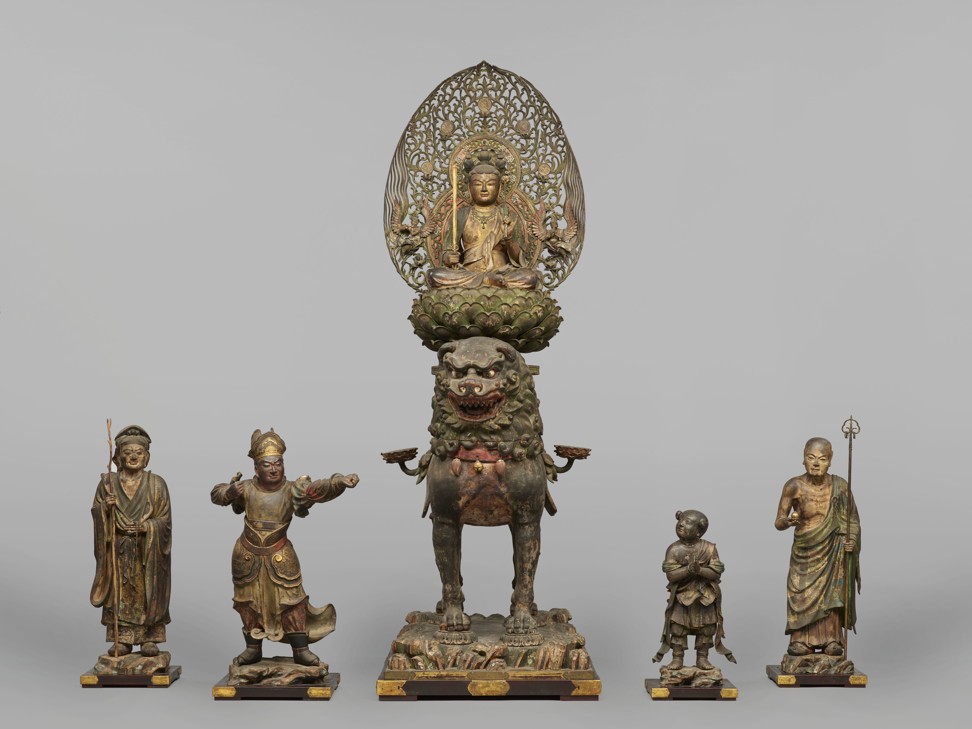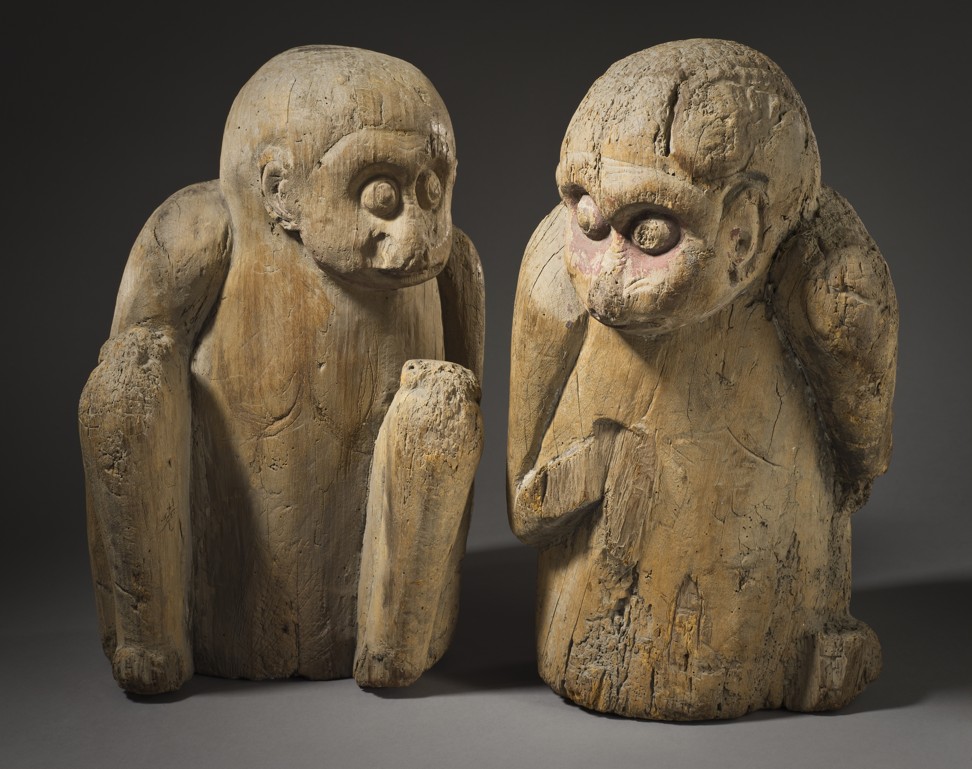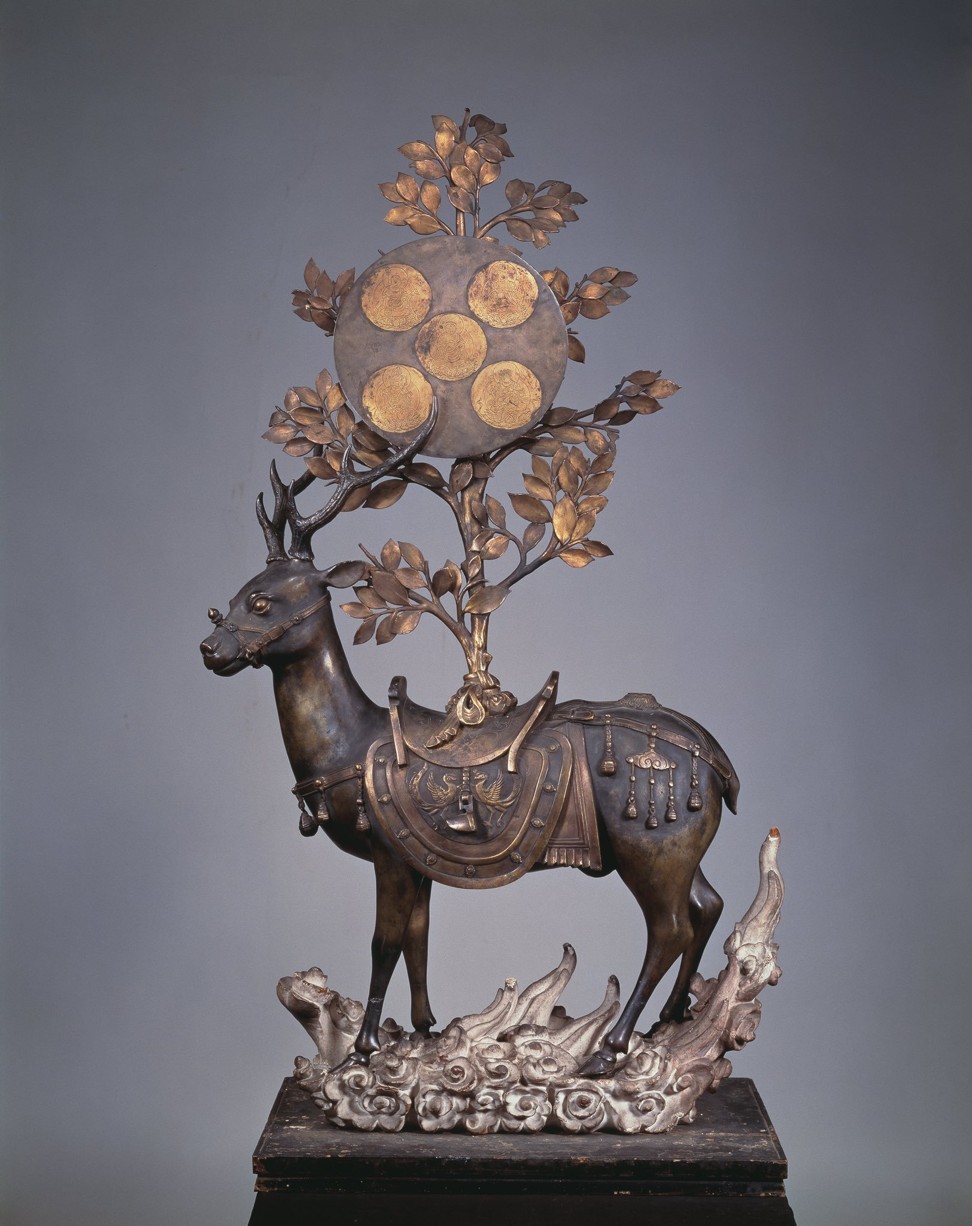
‘Interspecies erotica’ and exotic animals illustrate Japan’s history of cultural exchange at Washington gallery
- The Life of Animals in Japanese Art at the National Gallery of Art takes a thematic approach to explore the breadth of Japanese creation
- Rich and intellectually rewarding, the show features textiles, ceramics, armour, weapons, masks, figurines and dishware

Some of the oldest and newest objects in “The Life of Animals in Japanese Art” face off in the space just outside the exhibition entrance, at the National Gallery of Art, in Washington.
Yapping silently at visitors are three of Yayoi Kusama’s brightly painted, polka-dot-festooned dogs, while nearby stands a stolid earthenware sculpture of a bridled horse with saddle, made for a burial mound in the sixth century.
The dissonance between new and old, plastic and clay, pop icon and historic artefact resolves itself nicely in this exhibition, full of rare and ancient objects as well as contemporary photography, painting and video.
The show was co-organised by the Japan Foundation and includes works from the Tokyo National Museum that rarely travel. And it uses a thematic approach to give a substantial overview of the history and breadth of Japanese artistic creation.
The old and new animals in the atrium space outside the East Building special exhibition galleries also bookend the historical range of this show – from just before the arrival of Buddhism in Japan, in the sixth century, to the present moment, in which animals remain essential to art, entertainment and the pervasive production of adorable kitsch that strikes visitors to the country as a strange and surreal cultural tic.

With Buddhism, imported from China (where it had arrived from India about 500 years earlier), came new animals, including those not native to Japan. Among the more intriguing sculptures is a ferocious-looking elephant with six tusks and legs that bend backward (like those of a horse).
This 13th-century Japanese response to an unfamiliar animal has almost the same menacing stance as German artist Albrecht Dürer’s imaginary armour-plated rhinoceros, a woodcut from the 16th century also based on zoological hearsay.
Also imported from China, and strongly tied to Buddhism, were the animals of the zodiac and those associated with Buddhist deities or protectors.
A lion as fanciful as the imaginary elephant is a central figure in a set of wooden statues from the Kamakura period (1185-1333), depicting a bas atsu (or bodhisattva) riding a distinctly Chinese-looking beast with furrowed eyebrows, red-rimmed eyes and a wide, toothy mouth in full roar.
And yet, the figure it bears, Monju Bosatsu, is serene and childlike and represents wisdom. He carries a sword that was said to cut through confusion and mendacity.
Animals also entered Japanese artistic culture through poetry and literature. Poets had a regular storehouse of animal tropes to suggest a mood, analogise some aspect of human frailty, folly or fancy, and connect their work with that of earlier poets in a tradition that was deeply self-conscious about historical precedents.
And yet these tropes weren’t necessarily so polished by overuse as to be meaningless (“rosy-fingered dawn …”) but seemed to focus attention on small details of the natural world, like an incantation to awareness or sympathy.

A little time spent with Japanese poetry, especially haiku, helps animate many of the beautiful painted screens and prints in the exhibition.
Then there is the Edo-period woodblock print Abalone Fishergirl With an Octopus (circa 1773-1774), in which a randy cephalopod is well along in his seduction of a bare-chested girl.
It belongs to a larger tradition of what might be called octopus porn, or “interspecies erotica”, which also made an appearance in the television series Mad Men.
Japan is an island nation that was culturally insular for long periods, so the exhibition often seems to be about arrivals and discoveries. From the 16th century, Portuguese and then Dutch traders brought animals just as exotic as the lions and elephants of the Buddhist cultural transfer.
A magnificent painted screen from the Momoyama period, made around 1600, depicts the trade between “southern barbarians”, as the Portuguese were known, and Nagasaki, where a procession of newly arrived merchants includes a peacock, parrots and European hunting dogs.
By the Edo period (1603-1868), animals were also becoming pets, as they were in Europe, and with that, new layers of psychological meaning are overlaid on older forms of representation.
Among the highlights is another screen, a mostly monochromatic image in grey, black and white, made by Maruyama Okyo. It depicts puppies romping in the snow, and dog lovers (warning!) will plotz with delight.
No aspect of Japanese culture seems to be missing here. Animals were used as political allegories and stand-in figures for political criticism during periods of repression. They were used in rituals, including release-from-captivity ceremonies that accrued merit to those who performed them.
They were mythical, allegorical, magical and sometimes terrifying, but they were also protectors and guides. And sometimes the better-looking foxes mated with human men and produced children.
The woodblock print Kuzunoha, the Fox-Wife Parting From Her Child (1890) shows the back of an elegantly dressed woman leaving a room, where a child gently touches her gown. Seen in shadow through a rice-paper window is her head, with the snout and ears of a fox.

The exhibition ends with a room full of dresses designed by Issey Miyake, pleated forms that recall creatures from the monkey to the cicada to the starfish.
Along two walls of this gallery is Takashi Murakami’s giant 2014 painting, In the Land of the Dead, Stepping on the Tail of a Rainbow, painted in response to the devastating 2011 Tohoku earthquake and tsunami. It, too, is full of animal figures, as well as references to Edo-period and 13th-century works.
This is the rare exhibition at the National Gallery of Art that is easily, happily and – with the exception of one slightly naughty octopus – fully family friendly, with textiles, ceramics (a 19th-century footed bowl with crabs is a stunner), armour, weapons, masks, figurines and dishware.
But it is also a rich and intellectually rewarding show that makes real what is often discussed but rarely realised in similar exhibitions – the power of cultural exchange.
If you have time to engage with the more than 300 works on view, many of them national treasures, the animals depicted become a bit of pretext for a larger study of Japanese artistic traditions.
However, if you just want to look at animals – deer painted with strokes so feathery they seem like tufts of fuzz on the image surface, or a monkey with a long arm reaching (foolishly? or with human faith in the impossible?) for the reflection of the moon on placid water – the exhibition is equally absorbing.
No matter which approach you take for this mammoth 18,000 sq ft show, you will leave wanting more and wishing you could spend more time in a country that was, less than a century ago, a fierce imperial power and enemy and is now, to borrow another animal image (a painting by American artist Edward Hicks that seems curiously Japanese), a peaceable kingdom.
“The Life of Animals in Japanese Art” runs at the National Gallery of Art, in Washington, until August 18.
Text: The Washington Post